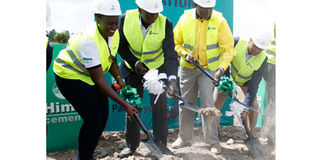Cement companies rush to set up new plants in Tororo

Left - right: Hima Cement Tororo project manager Sheila Byenkya, Hima Cement chairman Hannington Karuhanga, State minister for Minerals Peter Lokeris, and Hima Cement CEO Daniel Petterson at the groundbreaking ceremony in Tororo yesterday. COURTSEY PHOTO
What you need to know:
- Reason. Expansion is due to anticipated demand from large infrastructure projects and oil and gas.
Tororo.
Tororo District will by 2018 have at least three cement factories, after previously only having one, Tororo Cement.
Simba Cement, a Kenyan company, will by end of 2017 have completed a grinding plant just on the Tororo-Mbale highway in Nyakesi village.
Hardly a kilometre from their site, Hima Cement is also expected to have started production by June 2018 on its $40m (Shs144b) plant, also located in Tororo District.
Tororo Cement has previously been the only operational cement factory in Tororo.
However, Tororo Cement is also expanding its own capacity in Tororo with an investment valued at $50m (Shs180b).
Accessible raw material
According to Mr Daniel Petterson, the chief executive officer Hima Cement, Tororo presents an opportunity for better access to limestone, a key raw material used in the cement production process.
Mr Petterson said this at the groundbreaking ceremony for the plant in Tororo on yesterday.
He said: “We have a strong position in western Uganda. We are taking a strong position on Eastern Uganda. We believe this would be a good footprint for us.
“Secondly, we have access to raw material such as pozzolana in the districts surrounding Tororo.”
He added: “We want to solidify our presence in Uganda because of our good experience in investing in the country.
The access to limestone is mainly in Moroto where Hima Cement is exploring for limestone.
By 2018, the company expects to have determined the quantity of limestone and secure mining lease.
Additionally, the northeastern part of Uganda is one of the remaining areas in Uganda with viable limestone deposits, which explains the expansion drive being seen around Tororo.
That will increase Hima’s production capacity from 0.9 million Metric Tonnes per year to 1.9 million Metric Tonnes per year.
Tororo Cement’s capacity is also expected to expand from 1.8 million Metric Tonnes per year to 3 million metric tonnes per year. Simba Cement will be producing in excess of 1 million Metric Tonnes per year.
“The construction sector in Uganda is rebounding as shown by the sustained increase in demand for cement; currently at 10 per cent per year. Our capacity expansion drive aims at meeting this demand for not only within Uganda but the regional market as well,” Mr Petterson said.
This growth will also be driven by increased public sector investment in infrastructure projects such as the Standard Gauge Railway and anticipation of demand from the oil and gas sector projects like the oil refinery, pipelines and storage facilities.
Uganda’s domestic consumption of cement is estimated at 2.2 million metric tonnes, however, the existing factory capacity is about 2.6 million metric tonnes.
Another 100,000 metric tonnes is imported from Kenya, United Arab Emirates and Ethiopia, among others.
Boosting output
According to Mr Micheal Werikhe, the State minister for Industry, the increased expansion of factories presents opportunities for Uganda to export to the DRC, Rwanda and South Sudan.
More critically, however, is that the increased production should facilitate the reduction in prices of cement.
“Last year we released a rise in prices of cement driven by reduced production by the factories. With the increased factories and expansion, we hope there will be a reduction in prices of cement that will translate into lower costs of construction,” said Mr Peter Lokeris, the State minister for Minerals.
With the expansion of the various factories, production is expected to reach about 5.9 million metric tonnes per year.
Speaking about the development, Tororo Cement process manager Peter Karanja said: “We are the market leaders controlling 60 per cent of the market share. We are also setting up a bigger plant that will double our production.”




